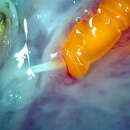Pomphorhynchidae is a family of parasitic worms from the order Echinorhynchida.
Species
Pomphorhynchidae has five genera which contain the following species:[1][a]
Longicollum Yamaguti, 1935
-
Longicollum alemniscus (Harada, 1935)
-
Longicollum cadenati Gupta & Naqvi, 1984
-
Longicollum chabanaudi Dollfus & Golvan, 1963
-
Longicollum dattai Saxena, Johri & Gupta, 2008
-
Longicollum edmondsi Golvan, 1969
-
Longicollum engraulisi Gupta & Fatma, 1985
-
Longicollum indicum Gupta & Gupta, 1970
-
Longicollum lutjani Jain & Gupta, 1980
-
Longicollum noellae Golvan, 1969
-
Longicollum pagrosomi Yamaguti, 1935
L. pagrosomi was found parasitizing the Atlantic horse mackerel (Trachurus trachurus) in the bay of Gemlik, Turkey. The body was between 5036 and 10164 µm long and 478 and 878) µm wide. The proboscis was cylindrical, wider anteriorly, between 2310 and 5313 µm long, and armed with 11 or 12 rows of hooks comprising 11 to 13 hooks in each. The anterior hooks were smaller than the posterior, measuring 34 (24 – 42) µm, 42 (40 – 44) µm, to 61 (54 – 70) µm long. The short proboscis sac consisted of two membranes. The lemnisci were level with the proboscis. One immature male sample had two spherical testes, 216 × 272 µm in diameter. The copulatory bursa was 80 by 140 µm. The cement glands were indistinct. The eggs measured between 70 and 210 µm long and 17 and 52 µm wide.[2]
-
Longicollum psettodesai Gupta & Gupta, 1980
-
Longicollum quiloni Gupta & Naqvi, 1984
-
Longicollum riouxi Golvan, 1969
-
Paralongicollum Amin, Bauer & Sidorov, 1991
-
Pomphorhynchus Monticelli, 1905
-
Pomphorhynchus bosniacus Kistaroly and Cankovic, 1969
-
Pomphorhynchus bufonis Fotedar, Duda and Raina, 1970
-
Pomphorhynchus bulbocolli Linkins in Van Cleave, 1919
-
Pomphorhynchus bullocki Gupta and Lata, 1968
-
Pomphorhynchus cylindrica Wang and Gu, 1983
-
Pomphorhynchus dubious Kaw, 1941
-
Pomphorhynchus francoisae Golvan, 1969
-
Pomphorhynchus jammuensis Fotedar and Dhar, 1977
-
Pomphorhynchus kashmirensis Kaw, 1941
-
Pomphorhynchus kawi Fotedar, Duda and Raina, 1970
-
Pomphorhynchus kostylewi Petrochenko, 1956
-
Pomphorhynchus laevis (Zoega in Müller, 1776)
P. laevis is a parasitic acanthocephalan worm that can influence the reaction of its intermediate host, the freshwater amphipod Gammarus pulex, to the smell of potential predators like perch, Perca fluviatilis.[3][4]
P. laevis facilitates its movement from its initial host. Research has demonstrated that organisms affected by the parasite exhibit a diminished or inverted avoidance response to the scent of predators when compared to uninfested specimens, supporting the notion that the parasite manipulates its host, with the goal of passing itself on to its definitive host, a freshwater fish. Affected specimens also demonstrate vibrant changes in color, making them more visible to predators.[5][6]
This worm swells its proboscis to press microneedles into the intestinal wall, with a very strong adhesive force. This has inspired a structural skin graft adhesive that sticks strongly but has minimal tissue damage while in place and upon removal.[7]
-
Pomphorhynchus lucyi Williams & Rogers, 1984
-
Pomphorhynchus megacanthus Fotedar and Dhar, 1977
-
Pomphorhynchus moyanoi Olmes and Habit, 2007
-
Pomphorhynchus omarsegundoi Arredondo and Gil de Pertierra, 2010
-
Pomphorhynchus oreini Fotedar and Dhar, 1977
-
Pomphorhynchus orientalis Fotedar and Dhar, 1977
-
Pomphorhynchus patagonicus Ortubay, Ubeda, Semenas and Kennedy, 1991
-
Pomphorhynchus perforator (von Linstow, 1908)
-
Pomphorhynchus purhepechus García-Varela, Mendoza-Garfias, Choudhury & Pérez-Ponce de León, 2017
-
Pomphorhynchus rocci Cordonnier & Ward, 1967
-
Pomphorhynchus sebastichthydis Yamaguti, 1939
-
Pomphorhynchus sphaericus Pertierra, Spatz and Doma, 1996
-
Pomphorhynchus spindletruncatus Amin, Abdullah and Mhaisen, 2003
-
Pomphorhynchus tereticollis (Rudolphi, 1809)
-
Pomphorhynchus tori Fotedar and Dhar, 1977
-
Pomphorhynchus yamagutii Schmidt and Higgins, 1973
-
Pomphorhynchus yunnanensis Wang, 1981
-
Pomphorhynchus zhoushanensis Li, Chen, Amin & Yang, 2017
Tenuiproboscis Yamaguti, 1935
-
Tenuiproboscis bilqeesae Gupta & Naqvi, 1992
-
Tenuiproboscis clupei Gupta & Sinha, 1992
-
Tenuiproboscis edmondi Gupta & Naqvi, 1992
-
Tenuiproboscis ernakulensis Gupta & Naqvi, 1992
-
Tenuiproboscis guptai Gupta & Sinha, 1989
-
Tenuiproboscis keralensis Kaur, Shamal, Chandran, Binesh, Gishnu, Asokan & Sanil, 2017
-
Tenuiproboscis meyeri Saxena & Gupta, 2007
-
Tenuiproboscis misgurni Yamaguti, 1935
Notes
-
^ A binomial authority in parentheses indicates that the species was originally described in a genus other than the present genus.
References
-
^ "ITIS - Report: Pomphorhynchidae". Itis.gov. Retrieved 11 April 2022.
-
^ Oğuz, M. C.; Kvach, Y. (2006). "Occurrence of acanthocephalans in teleost fishes of Gemlik Bay, Sea of Marmara, Turkey" (PDF). Helminthologia. 43 (2): 103–108. Retrieved 11 April 2022.
-
^ Kullmann, Harald; Timo Thünken; Sebastian A Baldauf; Theo C M Bakker; Joachim G Frommen (2008). "Fish odour triggers conspecific attraction behaviour in an aquatic invertebrate". Biol. Lett. An der Immenburg 1, 53121, Bonn, Germany: University of Bonn, Institute for Evolutionary Biology and Ecology. 4 (5): 458–60. doi:10.1098/rsbl.2008.0246. PMC 2610077. PMID 18593668.
{{cite journal}}: CS1 maint: location (link) -
^ Choi, Charles Q. (February 8, 2007). "Parasitic Worms Alter Hosts' Sense of Smell to Better Its Lot in Life". Fox News. Retrieved 2008-07-03.
-
^ Baldauf, Sebastian A.; Timo Thünken; Joachim G Frommen; Theo C M Bakker; Oliver Heupel; Harald Kullmann (2007). "Infection with an acanthocephalan manipulates an amphipod's reaction to a fish predator's odours". International Journal for Parasitology. An der Immenburg 1, D-53121 Bonn, Germany: University of Bonn, Institute for Evolutionary Biology and Ecology. 37 (1): 61–5. doi:10.1016/j.ijpara.2006.09.003. PMID 17049528.
{{cite journal}}: CS1 maint: location (link) -
^ Bakker, Theo C.M.; Dominique Mazzi; Sarah Zala (June 1997). "Parasite Induced Changes in Behavior and Color Make Gammarus pulex More Prone to Fish Predation". Ecology. University of Bern, CH-3032 Hinterkappelen, Switzerland: Ecological Society of America. 78 (5): 1098–1104. doi:10.1890/0012-9658(1997)078[1098:PICIBA]2.0.CO;2. S2CID 85643670.
{{cite journal}}: CS1 maint: location (link) -
^ Seung Yun Yang; et al. (April 2013). "A bio-inspired swellable microneedle adhesive for mechanical interlocking with tissue". Nature Communications. Massachusetts (mixed): Macmillan. 4 (1702): 1702. Bibcode:2013NatCo...4.1702Y. doi:10.1038/ncomms2715. PMC 3660066. PMID 23591869.


